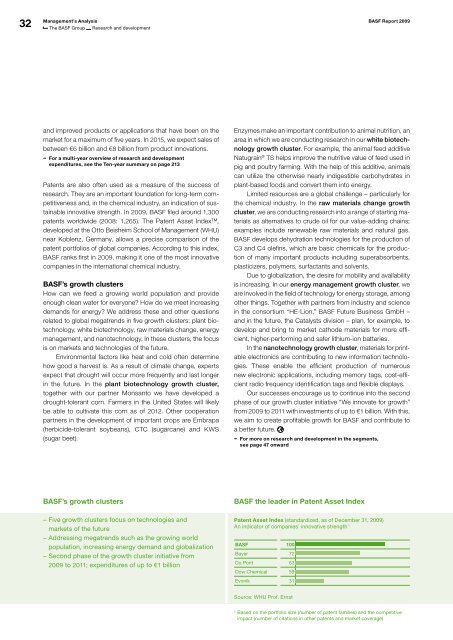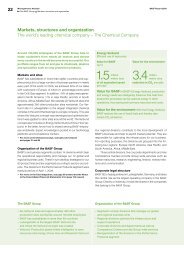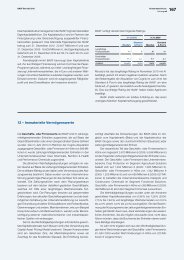BASF Report 2009 - BASF Report 2012
BASF Report 2009 - BASF Report 2012
BASF Report 2009 - BASF Report 2012
Create successful ePaper yourself
Turn your PDF publications into a flip-book with our unique Google optimized e-Paper software.
32<br />
Management’s Analysis <strong>BASF</strong> <strong>Report</strong> <strong>2009</strong><br />
The <strong>BASF</strong> Group<br />
Research and development<br />
and improved products or applications that have been on the<br />
market for a maximum of five years. In 2015, we expect sales of<br />
between €6 billion and €8 billion from product innovations.<br />
For a multi-year overview of research and development<br />
expenditures, see the Ten-year summary on page 213<br />
Patents are also often used as a measure of the success of<br />
research. They are an important foundation for long-term competitiveness<br />
and, in the chemical industry, an indication of sustainable<br />
innovative strength. In <strong>2009</strong>, <strong>BASF</strong> filed around 1,300<br />
patents worldwide (2008: 1,265). The Patent Asset Index,<br />
developed at the Otto Beisheim School of Management (WHU)<br />
near Koblenz, Germany, allows a precise comparison of the<br />
patent portfolios of global companies. According to this index,<br />
<strong>BASF</strong> ranks first in <strong>2009</strong>, making it one of the most innovative<br />
companies in the international chemical industry.<br />
<strong>BASF</strong>’s growth clusters<br />
How can we feed a growing world population and provide<br />
enough clean water for everyone How do we meet increasing<br />
demands for energy We address these and other questions<br />
related to global megatrends in five growth clusters: plant biotechnology,<br />
white biotechnology, raw materials change, energy<br />
management, and nanotechnology. In these clusters, the focus<br />
is on markets and technologies of the future.<br />
Environmental factors like heat and cold often determine<br />
how good a harvest is. As a result of climate change, experts<br />
expect that drought will occur more frequently and last longer<br />
in the future. In the plant biotechnology growth cluster,<br />
together with our partner Monsanto we have developed a<br />
drought-tolerant corn. Farmers in the United States will likely<br />
be able to cultivate this corn as of <strong>2012</strong>. Other cooperation<br />
partners in the development of important crops are Embrapa<br />
(herbicide-tolerant soybeans), CTC (sugarcane) and KWS<br />
(sugar beet).<br />
Enzymes make an important contribution to animal nutrition, an<br />
area in which we are conducting research in our white biotechnology<br />
growth cluster. For example, the animal feed additive<br />
Natugrain ® TS helps improve the nutritive value of feed used in<br />
pig and poultry farming. With the help of this additive, animals<br />
can utilize the otherwise nearly indigestible carbohydrates in<br />
plant-based foods and convert them into energy.<br />
Limited resources are a global challenge – particularly for<br />
the chemical industry. In the raw materials change growth<br />
cluster, we are conducting research into a range of starting materials<br />
as alternatives to crude oil for our value-adding chains;<br />
examples include renewable raw materials and natural gas.<br />
<strong>BASF</strong> develops dehydration technologies for the production of<br />
C3 and C4 olefins, which are basic chemicals for the production<br />
of many important products including superabsorbents,<br />
plasticizers, polymers, surfactants and solvents.<br />
Due to globalization, the desire for mobility and availability<br />
is increasing. In our energy management growth cluster, we<br />
are involved in the field of technology for energy storage, among<br />
other things. Together with partners from industry and science<br />
in the consortium “HE-Lion,” <strong>BASF</strong> Future Business GmbH –<br />
and in the future, the Catalysts division – plan, for example, to<br />
develop and bring to market cathode materials for more efficient,<br />
higher-performing and safer lithium-ion batteries.<br />
In the nanotechnology growth cluster, materials for printable<br />
electronics are contributing to new information technologies.<br />
These enable the efficient production of numerous<br />
new electronic applications, including memory tags, cost-efficient<br />
radio frequency identification tags and flexible displays.<br />
Our successes encourage us to continue into the second<br />
phase of our growth cluster initiative “We innovate for growth”<br />
from <strong>2009</strong> to 2011 with investments of up to €1 billion. With this,<br />
we aim to create profitable growth for <strong>BASF</strong> and contribute to<br />
a better future.<br />
For more on research and development in the segments,<br />
see page 47 onward<br />
<strong>BASF</strong>’s growth clusters<br />
– Five growth clusters focus on technologies and<br />
markets of the future<br />
– Addressing megatrends such as the growing world<br />
population, increasing energy demand and globalization<br />
– Second phase of the growth cluster initiative from<br />
<strong>2009</strong> to 2011; expenditures of up to €1 billion<br />
<strong>BASF</strong> the leader in Patent Asset Index<br />
Patent Asset Index (standardized, as of December 31, <strong>2009</strong>)<br />
An indicator of companies’ innovative strength 1<br />
<strong>BASF</strong> 100<br />
Bayer 72<br />
Du Pont 63<br />
Dow Chemical 59<br />
Evonik 31<br />
Source: WHU Prof. Ernst<br />
1<br />
Based on the portfolio size (number of patent families) and the competitive<br />
impact (number of citations in other patents and market coverage)




